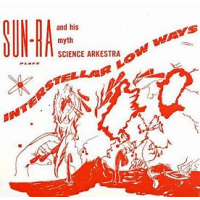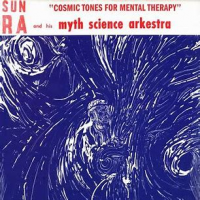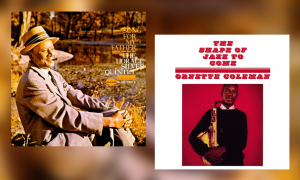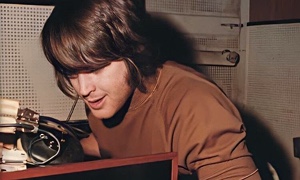Home » Jazz Articles » Building a Jazz Library » Sun Ra: Ten Great AfroFuturist Albums
Sun Ra: Ten Great AfroFuturist Albums

Sun Ra’s statement, musically and spoken, is that this is a primitive world. Its practices, beliefs, religions, are uneducated, unenlightened, savage, destructive, already in the past. That’s why Sun Ra returned only to say he left. Into the Future. Into Space.
—Amiri Baraka
One thing that is indisputable, however, is that each of the albums below is a work of genius which deserves its place in any serious jazz library. The material on them was recorded between 1952 or 1953 and 1991, mostly by medium and large scale ensembles. A few tracks were made with small groups and fewer still by Ra alone.
Ra's earthly biography is straightforward enough. It is known that he was born in Birmingham, Alabama on May 22. No birth certificate survives, but the year was probably 1914 and Ra's given name was probably Herman Blount. He studied music at Alabama A&M University during the 1935-36 academic year, but the Great Depression was still in full effect and Ra had to leave when his family could no longer afford the tuition fees. For the most part, Ra was a musical autodidact, just as he was a philosophical one (he was a voracious reader of mainstream and alternative literature, from heavyweight hardbacks to mimeographed pamphlets).
Ra made his first recordings in 1946 in Nashville, accompanying the blues singer Wynonie Harris. The same year, he moved to Chicago, where he wrote arrangements for Fletcher Henderson's band. Around 1950, he formed his Space Trio with alto and baritone saxophonist Pat Patrick and drummer Tommy Hunter; both players were founder members of Ra's Arkestra circa 1953 and stayed with him, on and off, for decades. Two or three years later, Ra formed his own recording company, El Saturn, with his longtime associate Alton Abrahams. In 1961, after a few months in Toronto, Ra moved his operations to New York, and in late 1968 or early 1969 to Philadelphia. He passed in 1993.
Ra consistently denied the early part of this biography. In 1952, he claimed that he was not human, but had been born on Saturn and was of an angel race; moreover, he had in previous incarnations been around Planet Earth for around a thousand years. Ra said he was a Cosmic Communicator, charged with bringing the Creator's message to a benighted Earth. Accordingly, also in 1952, he changed his name to Le Sony'r Ra, after the Egyptian sun god.
A question most Ra enthusiasts ask is: did he really believe that stuff? Common sense says that the answer, of course, is that he did not. Ra was intellectual not delusional and he was no snake-oil salesman. His public persona and world view were cosmic metaphors. We do not know where or when Ra's AfroFuturism originated, but his biographer Robert L. Campbell says that in 1951 Ra fell in with a secret society on the South Side of Chicago whose members studied the occult, advocated a form of Black Nationalism and preached about outer space. Ra, likely already on the pathway, took it from there.
Amiri Baraka nailed where Ra and first-wave AfroFuturism were coming from better than anyone. "Sun Ra's consistent statement, musically and spoken, is that this is a primitive world," wrote Baraka in 1993. "Its practices, beliefs, religions, are uneducated, unenlightened, savage, destructive, already in the past. That's why Sun Ra returned only to say he left. Into the Future. Into Space."
So strap yourself metaphorically in and enjoy the ride....
Sun Ra: Ten AfroFuturist Masterpieces
Recording and release dates given below are sourced from Chris Trent's research, the Rosetta Stone of Ra discographical scholarship. Le Sun Ra and His Arkestra
Le Sun Ra and His Arkestra Jazz in Silhouette
Saturn, recorded and released 1959
One of the charges levelled at Ornette Coleman is that he never mastered the changes-based tradition which he rejected. According to his detractors, Coleman's harmolodic theory was a smokescreen designed to conceal basic musical illiteracy. The same critics observe that throughout his career Coleman avoided playing in situations that required facility with the changes. Whether any of this renders his work invalid is, of course, a matter of opinion.
As iconoclastic as Coleman and then some, Sun Ra cannot be accused of illiteracy. Throughout his career, he worked inside and outside with equal ease. Nowhere is his grasp of the tradition clearer than on the swing-based masterpiece Jazz In Silhouette—the provenance of which, bar one track, would elude any Blindfold Test participant with the exception of anyone who already owns the album. Ra's futurist proclivities are indicated only on "Ancient Aiethopia," in which his spacey Wurlitzer introduces chirruping flutes, thunderous tympani and a spellbinding inside/outside solo from trumpeter Hobart Dotson. The track concludes with the bandmembers speaking in tongues.
The ten-piece line-up also includes James Spaulding on alto saxophone and flute and such longtime Ra sidepersons as alto saxophonist Marshall Allen, tenor saxophonist John Gilmore, baritone saxophonist Pat Patrick and bassist Ronnie Boykins.
 Sun Ra and His Myth Science Arkestra
Sun Ra and His Myth Science Arkestra Interstellar Low Ways
Saturn, recorded 1959-60, released 1967
From its inception, Saturn's finances were in a chronically parlous state. A consequence was that, while Ra was assiduous in chronicling the Arkestra's work—often by home recording its rehearsals and live performances—taped material often remained unreleased for up to a decade, or longer, until Saturn's cashflow caught up with the backlog. Interstellar Low Ways is one of a group of Saturn albums that were recorded in whole or in part before Jazz In Silhouette, but which were not released until the mid or late 1960s. Others include We Travel The Spaceways (recorded 1956-1961, released 1967), Angels And Demons At Play (recorded 1956-1960, released 1965) and Lady With The Golden Stockings aka The Nubians Of Plutonia (recorded 1958-59, released 1966).
Most of the tracks on these albums are at least as far out as Jazz In Silhouette's "Ancient Aiethiopia." Interstellar Low Ways, for instance, consists almost entirely of AfroFuturist material. The many highpoints include "Rocket Number Nine Take Off For The Planet Venus," in which the bandmembers' chant "Zoom! Zoom! Up! Up! Up in the air!" introduces a frantic, outside John Gilmore tenor solo, and which concludes with the iterated chant "Second stop is Jupiter" and the closing announcement "All out For Jupiter." Also outstanding are "Space Loneliness," a showcase for a disconsolate Allen alto, and "Space Aura," made memorable by George Hudson's deliciously elemental trumpet.
 Sun Ra and His Myth Science Arkestra
Sun Ra and His Myth Science Arkestra Cosmic Tones For Mental Therapy
Saturn, recorded 1963, released 1967
The word "psychedelic" had been in use since the mid 1950s but had yet to be applied to music when Cosmic Tones For Mental Therapy was recorded in 1963. Not so, of course, by the time it was released in 1967. The sound is reminiscent of some of La Monte Young's out-of-its-tree contemporaneous work, the result of Ra giving the Arkestra's budding electronicist Tommy Hunter licence to treat the session tapes with massive amounts of reverb and tonal distortion.
Most of the tracks were recorded after hours at the Tip Top Club in Brooklyn, where Hunter was in a trio accompanying a singer. Ra, unusually, plays a Hammond B-3 (the trio's keyboard player kept one on stage)—but do not think Jimmy Smith so much as Timothy Leary with a head full of Stanley Owsley's finest. Other tracks were recorded at Manhattan's Choreographers' Workshop, which had affordable rehearsal space which Ra often used in the early 1960s; on these, Ra plays Clavioline and cosmic side drum. Standouts include "Moon Dance," in which Ra repurposes the B-3 as a primal drum machine, and "And Otherness," where his arrangement focuses on low register clusters of Bernard Pettaway's bass trombone and John Gilmore and Robert Cummings' bass clarinets, and "Thither And Yon," where Hunter transforms Marshall Allen's oboe into signals from deep space.
 Sun Ra and His Solar Arkestra
Sun Ra and His Solar Arkestra The Heliocentric Worlds Of Sun Ra Volume 2
ESP-Disk, recorded and released 1965
Before ESP-Disk's release of the Heliocentric Worlds albums, which cross-pollinate space jazz and conservatoire art music to the benefit of both and of which Volume 2 is a landmark in Ra's development as a composer, knowledge of Ra's music was confined to a tiny audience which followed the Arkestra on its neighbourhood gigs and bought the self-released albums that were on sale at the performances. The shortlived pact with Bernard Stollman's label raised Ra's profile significantly. Unlike Saturn, ESP had some semblance of a distribution network, mainly in New York but also in London and other major European cities. And because Stollman was a white man, he was able to get his foot in the door of the more adventurous end of the mainstream media, most of whose jazz critics were in 1965 entirely unaware of Ra.
Stollman did not, however, make many converts overnight. Martin Williams, for instance, who had been an early champion of Ornette Coleman and appreciated Albert Ayler and Cecil Taylor, dismissed the side-long "The Sun Myth," arguably Volume 2's chef d'oeuvre (though the exquisitely delicate "A House Of Beauty" runs it a close second), as "soundtrack music from a bad science fiction movie." Ira Gitler harrumphed about "so-called space music" and "incoherent goings-on." Almost alone among the gatekeepers who did get Heliocentric Worlds was Voice Of America broadcaster Willis Conover, who began beaming Ra out to Europe almost nightly. (In 2021, the Swiss label ezz-thetics released the CD Heliocentric Worlds 1 & 2 Revisited, containing immaculately remastered editions of both albums).
 Sun Ra and His Solar Arkestra
Sun Ra and His Solar Arkestra The Magic City
Saturn, recorded 1965, released 1966
The Magic City's close comparator is John Coltrane's Ascension (Impulse, 1966), which inhabited the same bracing zeitgeist. Both title tracks were recorded within a few weeks of each other, "The Magic City" on May 25, 1965, "Ascension" on June 28. (Ra accused most of his contemporary innovators, including Coltrane, of stealing his ideas, beginning in the mid-1950s in Chicago, when he said Ahmad Jamal was ripping off his pianism; at the time, Jamal was playing at the Lounge at the Pershing Hotel and Ra was leading a trio in a smaller room in the basement).
Both "The Magic City" and "Ascension" were extended works, collectively improvised by mid-sized ensembles with a bare minimum of direction by the bandleaders. Coltrane set out the solo order on "Ascension" in advance and, during recording, used a series of prearranged prompts to signal when a new modal centre was to be adopted. Ra's prompts on "The Magic City" were a little more detailed, as one might expect from a bandleader who was loathe ever to completely drop the reins; he used them to sequence soloists and to signal the start and end of small group interludes and cue a few sketchily arranged themes. "The Magic City"—which clocks in at just over twenty-seven minutes and took up the first side of the original LP—also bears evidence of tape editing at various points (unlike "Ascension") and as on Cosmic Tones For Mental Therapy, Tommy Hunter was once again on reverb duty, though this time with a lighter touch.
 Sun Ra and His Solar-Myth Arkestra
Sun Ra and His Solar-Myth Arkestra The Solar Myth Approach Vol. 1 & 2
BYG, recorded 1967-70, released 1971
Like Duke Ellington, Sun Ra's primary instrument was his band. But he was also a fascinatingly inventive keyboard player, not so much on the acoustic piano, on which he intermittently recorded solo albums, but on electronic instruments, where his concern was with new textures rather than linear improvisation. For the most part, the Solar Myth discs are not solo albums, but it is Ra's keyboards rather than the Arkestra which are the main focus of attention and which take the majority of the solos. Ra plays Hohner Clavinet, electric celeste, Mini Moog, synth strings, acoustic piano, Spacemaster organ and Gibson Kalamazoo along with percussion, and the sounds he conjures are as spacey as the range of instruments suggest. Marshall Allen and John Gilmore take occasional alto and tenor solos, but like the rest of the Arkestra are mainly heard on stringed and percussion instruments, providing the soundscape for Ra's keyboards.
Arkestra vocalist June Tyson is featured on two tracks, "The Satellites Are Spinning" and "Outer Spaceways Incorporated," both of which Ra rearranged for the soundtrack of the semi-biographical film Space Is The Place (1974).
 Sun Ra
Sun Ra Astro Black
Impulse, recorded 1972, released 1973
In 1972, Impulse began negotiations with Saturn to rerelease Ra's back catalogue and record some new albums. The deal had the potential to put the Arkestra's finances on a solid footing, but Impulse reckoned without Ra's lifelong determination to do everything on his own terms. He ultimately refused to sign Impulse's contract and presented an alternative version of his own. Here is a sample clause: "6. Similar Rights On Planets Other Than Earth. Company agrees that all rights discussed in paragraph 5 above, as well as all rights of distribution and retail sales, on planets other than Earth (including but not limited to Saturn, Pluto, Jupiter, and Mars) shall belong to Sun Ra." Impulse's corporate owners, ABC-Paramount, were so freaked out by this and other clauses that in late 1974 or early 1975 they pulled Impulse out of the deal. By that time, nine albums had been released under the terms of a provisional agreement, including reissues of Jazz In Silhouette and The Magic City and the newly recorded Astro Black, and another twelve had been given catalogue numbers and new cover art.
Astro Black was recorded in a high-end Chicago studio in May 1972, according to the liner notes in El Saturn Studio, which did not exist. The other newly recorded album released before Impulse pulled the plug is the stereo/quadrophonic compatible Pathways To Unknown Worlds, credited to Sun Ra and His Astro Infinity Arkestra, which was recorded in New York's Variety studio. Both albums have excellent audio, were made with large lineups and are among Ra's best releases of the early 1970s.
 Sun Ra
Sun Ra Lanquidity
Philly Jazz, recorded and released 1978
No two, or anyway very few, of Ra's many albums resemble each other, and Lanquidity is as individual as anything else in the canon. Some Ra aficionados, however, have been pretty snooty about it, writing it off as jazz-funk going on contemporaneous Return to Forever fusion. The album has elements of both those things. But it is unmistakably a Ra project from beginning to end, with plenty of outer-limits soloing from Marshall Allen, John Gilmore, baritone saxophonist Danny Thompson, trumpeter Eddie Gale and Ra himself on ARP, Fender Rhodes, Yamaha organ, Hammond B3 organ, Moog Minimoog, acoustic piano, Crumar electronic keyboard and bells.
Despite the prevailing vibe being lush and laid back, Lanquidity is as rewarding as anything else the Arkestra recorded. It is also a rare example of the band being let off Ra's typically short leash—it was recorded during a late-night jam session with just a few sketchy head arrangements of the themes. It is, in short, a lovely post-coital / post-orbital album and nothing to be snooty about at all. (In 2022, Strut Records released a 2 x CD edition of Lanquidity containing both the original mix and an alternative one, which had been made in 1978 but rejected by Ra).
 Sun Ra
Sun Ra Disco 3000 (Complete Milan Concert)
Art Yard, recorded 1978, released 2007
By coincidence, the same year Ra recorded Disco 3000 (Complete Milan Concert), Ze Records was launched in New York with the motto "Mutant Disco" (a later one was "Fuck Art, Let's Dance"). Mutant disco pretty accurately describes much of the music from Ra's Milan concert, which was given by a quartet: Ra on Crumar Mainman, rhythm machine, organ and piano; Michael Ray on trumpet; John Gilmore on tenor saxophone and percussion; and Luqman Ali on drums. Ra had not brought a bassist to Italy so he programmed some bass ostinatos himself on the Mainman.
Art Yard's 2 x CD adds material not included on the LP Disco 3000 (Saturn, 1978). There are no longuers on either disc but an undoubted highlight is "Disco 3000" itself, which at twenty-six minutes took up all of side one on the original LP. The track is built around Ra's ostinatos and subtly twisted dance rhythms. Luqman is in his comfort zone; a relatively recent Arkestra recruit, his background was in soul and funk. Another highlight is "Dance Of The Cosmo Aliens," a cartoonish diversion which eventually reveals itself to be the traditional spiritual "Sometimes I Feel Like A Motherless Child" (for a more straight-ahead version check guitarist Grant Green's marvellous 1963 Blue Note album Feelin' The Spirit). The concert ends with a reprise of the Ra evergreen "We Travel The Spaceways."
 Sun Ra
Sun Ra Singles: The Definitive 45s Collection 1952 -1991
Strut, recorded 1952-91, released 2016
A 3 x CD treasure trove of exalted and ultra-rare material. The scope of the sixty-five tracks is extraordinary and the curatorial care with which they are presented by Ra scholars Paul Griffiths and Peter Dennett runs deep. Disc one opens with "I Am An Instrument" and "I Am Strange," vocal outings on which Ra accompanies himself on space harp and piano. The two tracks are thought to have been made in the early 1950s but are difficult to date with precision because the tape is a palimpsest: the material comes from paper tapes which were recorded, then partially over-recorded, at different times. In them, Ra sets out the fundamental musical, metaphysical and cosmological concepts that he explored during his lifetime.
The remaining sixty-three tracks take in space bop, hard bop, doo wop, show tunes, blues, calypso, psychedelia, swing and more. The thirty-two page booklet includes a 1993 interview with Alton Abrahams and informative track commentaries. It all adds up to a galactic bundle of words and music in which to get blissfully lost.
Tags
PREVIOUS / NEXT
Support All About Jazz
 All About Jazz has been a pillar of jazz since 1995, championing it as an art form and, more importantly, supporting the musicians who make it. Our enduring commitment has made "AAJ" one of the most culturally important websites of its kind, read by hundreds of thousands of fans, musicians and industry figures every month.
All About Jazz has been a pillar of jazz since 1995, championing it as an art form and, more importantly, supporting the musicians who make it. Our enduring commitment has made "AAJ" one of the most culturally important websites of its kind, read by hundreds of thousands of fans, musicians and industry figures every month.























